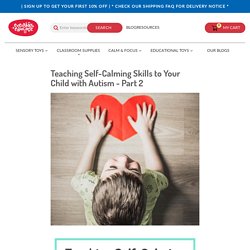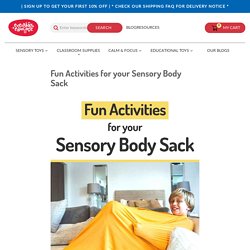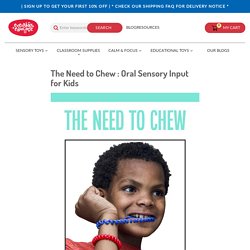

Everyday Educate
Our products serve to help children play, laugh, retain more information, build bodily movement, and interact with others. Additionally, we’re constantly partnering with teachers, directors, counselors, home-schooling parents, and principals to gain their feedback on what’s working and not working.
Sensory Rattles. Chewies. Sensory Sack. Self-Calming Skills for your Child with Autism Pt 1. If you are the parent of a child with autism, it may be hard to know how to help your child when they experience strong emotions.

All kids (and all adults!) Experience strong emotions from time to time. Self-Calming Skills for your Child with Autism Pt 2. See Part 1. 2.

Put Together a Calming Routine Once you’ve tested out some of these activities, make a list of three to five activities that you think will work best to help your child with self-calming. Mermaid Tail Blanket for Girls - Soft Kids Blankie Made by Minky Plush. Occupational Therapy Body Sock. For Sensory Seekers Must Have Occupational Therapy Tool Fun Sensory Filled Activity for Kids Parents, Teachers, Therapists Approved!

7 Calming Resources for Kids with Autism – EverydayEducate. Are you always anxious?

Do you feel that your anxiety has got the best of you? Benefits of Weighted Blankets – EverydayEducate. You've probably heard about weighted blankets.

They are everywhere being promoted to deliver a good night sleep to our kids and relieve them of anxiety and stress. But weighted blankets are more than that and its not just an ongoing trend. There is actually science behind this and our friend Julie, explains the scientific benefits of Weighted Blankets in detail on her blog, My Mundane and Miraculous Life. CLICK HERE to learn all about it and be fully informed before buying your first set of weighted blanket. Follow Everyday Educate on. Benefits of Weighted Blankets – EverydayEducate.
Autism-Friendly Vacation Ideas – EverydayEducate. Spring break is upon us and what better way to spend all this free time than by going on full vacation mode?

A change of scenery should be great but it may be extra challenging if your kids are on the spectrum as this also means a change in routine. As most kids in the spectrum, a routine is their comfort zone, when this is disrupted it may cause stress, anxiety and sensory overload. Traveling with kids with ASD can be unpredictable and comes with a set of difficulties and frustrations, both on you and for other travelers. This doesn’t mean you won’t have a fun time. You can consider places which are autism-friendly, places that can understand and can be flexible to accommodate your child’s needs. If you’re looking at vacation ideas on where to spend your spring break, here are some that are autism-friendly. Fun Activities for your Sensory Body Sack – EverydayEducate. If you're looking for a fun sensory tool for your kids, a Sensory Body Sack or Body Sock should be on top of your list.

First off, it's an awesome must-have for both sensory seekers and sensory avoiders. As the body sack is made of stretchy lycra fabric, sensory seekers can use this for big movement activities. If your child is an avoider, simply cocoon them inside the sack to calm down from all the stimulation. There are tons of activities which you can use this tool. A Journey with Sensory Processing Disorder – EverydayEducate. BY: Heather Campbell I knew before my son even walked down the steps of the school bus that day, preschool had been a struggle for him.

I could see it in the bus driver’s eyes, I could see it on the face of my other son, and I definitely could hear it from Braxton. I didn’t realize it at the time, but this day would forever be etched into our brains because it was the day we finally realized a little bit of what my son Braxton would need to better help him function successfully in life, school and socially. I couldn’t figure out if Braxton was hurt, or if something happened, and it didn’t matter what I tried, it wouldn’t work. He was in tears, and I was on the brink as well. He was never able to communicate with me what happened that day, or what set him off, but I finally knew there was a way I could help him to release his emotions and frustrations.
The Need to Chew : Oral Sensory Input for Kids – EverydayEducate. Why do kids chew?

As children, chewing is part of their oral development and sometimes, this ‘habit’ carries on into their adulthood. Chewing, biting, etc. can mean a lot of things for your kids and this should be addressed as part of your child’s needs. To be able to guide your kids towards a safer path for fulfilling their oral sensory needs, we have to know WHY they do this. Check out Julie of My Mundane and Miraculous Life, and click HERE to read the science behind the needs for oral sensory input. Knowing the reason why your kids do this kind of habit will help parents to meet their child’s needs by providing safer options like chewing jewelries.
Sensory Diet – EverydayEducate. By: Heather Campbell The first time I ever heard the phrase “sensory diet” I was sitting in an IEP meeting for my child.

I thought they must be crazy if they believed this would work. Didn’t they understand that trying to get my child to eat different types of food was not easy? He would eat Orange Chicken and Pot stickers all day, every day, but adding new or different foods, especially at school, was just not going to work. A Space for Mindfulness and Emotional Regulation – EverydayEducate. By: Zoey Bros In the olden days, unfavorable behavior resulted in time-outs, the hallway, or the principal’s office. As time has passed, schools have changed, including the way teachers respond to less than desired behavior in the classroom. In college, I remember during student teaching the popular shift was to the Responsive Classroom model. If you are familiar, this followed the “take a break” response. If students were struggling they were asked to “take a break” in a designated area of the classroom.
When I started my first teaching job I came across Leah Kuypers and the Zones of Regulation. This idea of a space centered around Zones of Regulations and Mindfulness tools that I teach started as a decorated student desk with tools and posters they could use, then the next school year changed into a Mindfulness corner chair with the same items in a bin underneath. This nook can be found in between my filing cabinet and a rather large bookshelf. In peace,Zoey. Fine Motor Skills For Kids With Sensory Issues – EverydayEducate. A kid's sensory issues does not only pertain to being overwhelmed with loud noises or sensory seeking through aggressive chewing, it can affect other crucial development such as their fine motor skills. Simple tasks like gripping a pen or tying shoe laces can be a major struggle for kids with sensory needs and that's why it's important for them to develop their fine motor skills in any way they can.
Mom Julie, explored fine motor sensory struggles in detail and how to develop fine motor skills for kids with sensory issues using fun activities you can do at home. Check out Julie's post from My Mundane and Miraculous Life and Click HERE to read all about fine motor skills and the activities you can do to develop it, including the use of building brick glasses. Follow Everyday Educate on. Therapy Exercises for Kids Using Carpet Markers – EverydayEducate. By: Kelly Hall Dear SLPs, this small little tool is about to change the way you do speech therapy!
It's small enough to fit in your purse.It's versatile enough that you could assign practically any speech therapy task to it.It encourages movement and playfulness while also supporting a structured session.And, last but not least: it can be used as a visual to support student learning and to reinforce attention and participation.
So, what am I talking about? Managing Light Sensitivity in the Classroom – EverydayEducate. By Zoey Bros One of the main things you’ll see when entering the Instagram teacher world is very colorful and stimulating photos of beautiful classroom decor inspiration. If you asked many of my followers they would probably tell you that they would sum up my Instagram feed look as bright and “rainbow everything”. There are many pages that also have classrooms that follow this same theme. While this trend is very impressive and has inspired me in many ways. I got to thinking about how to make my classroom more learner-friendly this past year. Recently, I have seen a lot of teacher grammers speak to scientific studies that showed many students struggled with a combination of stimulating colors and bright fluorescent lights.
Another small study I read reported similar results stating that fluorescent lighting increased the frequency of stereotypical repetitive behaviors in children with Autism. Enhancing Fine Motor Skills Using Building Brick – EverydayEducate. By: Caroline Naif Dear Occupational Therapists, Teachers, Moms & Dads… these awesome building brick glasses are a great way to incorporate fine motor skills practice with some fun imagination for endless creative designs that is fun for all ages!! Are you looking for a fun new way to practice fine motor skills at home or need to work on those pincher grasps? These building brick glasses are a perfect way for parent/child, OT/ patient, teachers in classrooms settings and even birthday parties to empower creativity and encourage the use of hands and fingers. Sensory Math Activities – EverydayEducate. Math is something that most of us adults glanced at with slight anxiety or dread.
Success in Inclusion for Students with Disabilities in a GenEd Classro – EverydayEducate. Inclusion matters! Facilitating positive and meaningful experiences for students with disabilities to learn with and alongside their typical peers in general education settings isn't easy, but it's necessary. Students with disabilities in inclusive classrooms have been shown to make academic gains in a number of areas,like improving their performance on standardized tests, mastering their IEP goals, grades, on-task behavior, and participation (National Center for Education Restructuring and Inclusion, 1995).
Research tells us that the pros of inclusive settings far and away outweigh the possible challenges, so how do we truly make inclusion successful? Here's 3 helpful tips for teachers to make these opportunities as seamless as possible. 1.) Is the student's special education classroom covered in visuals? 2.) One of the most powerful elements of inclusion are the social benefits from both the student being included, and the typical students. 3.) Classroom Management Made Easy with Sitting Spots – EverydayEducate. Tip 1: Use Sitting Spots During Carpet Time In elementary classrooms everywhere, teaching students how to sit on the carpet while learning is an important procedure to explicitly teach.
Students love to race one another to get there first; they also love sitting next to their best friend in class so they can chat during the lesson. Using Fidget Bands for Children with Attention Deficit Hyperactivity D – EverydayEducate. By: Brittany Archutowski Imagine being a young child who thrives on movement. You can’t quite grasp the overwhelming energy radiating through your body or understand how to control it. You feel the urge to wiggle, stand, shake, talk and fidget. Helping Students with Special Needs Regulate their Emotions and Behavi – EverydayEducate. By: Ashlei Funtjar. Can a Weighted Blanket Actually Help a Child with Anxiety? – EverydayEducate. By now, you've likely heard the claim that weighted blankets reduce anxiety and promote better sleep. But is it true? Math Rotations Made Easy Guided Math – EverydayEducate.
By: Sam Ripley About 3 years ago, I was sitting at my desk frustrated at the lack of growthI was seeing in math for my students. Growth Mindset - Bringing Positivity in Classroom Morning Meetings – EverydayEducate. Coming back from our winter break, we, as educators have so much work on our hands! One of the most important things we teach our students, aside from the general education, is how to have a positive attitude and a growth mindset! 5 Success Hacks For Distance Learning - Home Learning Routines – EverydayEducate.
While the word “school” may prompt groans under normal circumstances, the past months has been anything but normal. Using Coloring and Crafts for Speech and Language to Learn at Home – EverydayEducate. By: Chloe Hill, M.A., CCC-SLP. Educational Toys , Preschool Games & Early Child Education Resources – EverydayEducate.